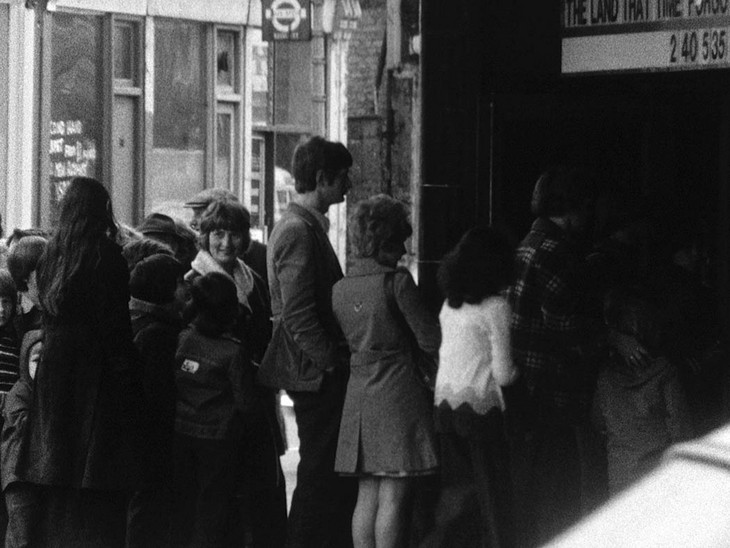(Not) the Voice of God
It is not that words are imperfect, or that, when confronted by the visible, they prove insuperably inadequate. Neither can be reduced to the other’s terms: it is in vain that we say what we see; what we see never resides in what we say.
Michel Foucault, The Order of Things: An Archaeology of the Human Sciences (1970)1
Michel Foucault, The Order of Things: An Archaeology of the Human Sciences (1970)1
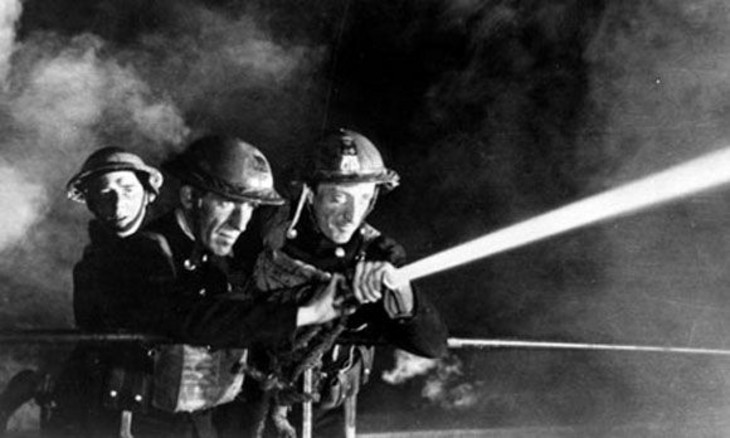
Humphrey Jennings
Fires Were Started 1943 (film still)
Fig.1
Humphrey Jennings
Fires Were Started 1943 (film still)
It was only through the arbitrariness of scheduling that The Girl Chewing Gum came to share the evening with Fires Were Started, but in fact this somewhat strange pairing makes a good deal of sense: albeit for very different reasons and to very different ends, both films are characterised by a productive contamination of fiction and non-fiction. Smith has discussed this aspect of his work, stating that ‘If I’m forced to put a label on my films, I’m happy to call many of them documentaries, especially if you go back to [John] Grierson’s definition of documentary as the “creative treatment of actuality”’.4 He elaborated on this position in his 1997 doctoral dissertation, entitled ‘Real Fiction’: ‘I am highly sceptical of the accepted distinction between “fiction” and “documentary”. Leaving aside philosophical arguments concerning the concept of “fact”, all film is fiction in that it is literally “made up” from controlled representations of selected interpretations of phenomena which are ordered selectively to construct meanings.’5
This twinned interest in documentary and the non-transparency of representation prevails throughout Smith’s practice, but is articulated with particular force in The Girl Chewing Gum in its exploration of the relations between language and image. Smith’s expanded definition of documentary and acknowledgement of the inevitability of fictionalisation are now widely held ideas – indeed, they are frequently deemed central to the so-called ‘new’ forms of documentary that prevail today in contemporary art – but this position was far less common in the 1970s. In The Girl Chewing Gum, Smith’s embrace of hybridity provides a cogent form for a powerful critique of documentary naturalism and, more specifically, one of its favoured techniques, the ‘voice of god’ – all while remaining grounded in a commitment to actuality.
The voice of god is a usually male voice, unmarked in accent, prevailing on the soundtrack of many traditional documentaries. It assumes total knowledge and mastery of what is seen onscreen by virtue of occupying a space resolutely heterogeneous to that of the image-track. The power of this voice is dependent on the absence of a body; it seems to speak from nowhere, deriving from this placelessness a superhuman omniscience. The Girl Chewing Gum does not present a voice of god in the strict sense, since conventionally, to quote the filmmaker and critic Pascal Bonitzer, this voice ‘forbids questioning about its enunciator, its place, and its time’.6 The opening minutes of The Girl Chewing Gum depart from this regime by allowing the spectator to assume that the voice is located in a space coterminous with the image, simply out of frame; in other words, the voice is initially presented as a voice-off rather than a voiceover. The distinction between these two terms is key in illuminating the way in which The Girl Chewing Gum subverts filmic conventions. The voice-off in cinema is defined as belonging to a character not visible in the frame and yet clearly present within the filmic universe. The voiceover, meanwhile, is extra-diegetic, occupying a space that is radically other; it derives authority from this transcendental position.7 The Girl Chewing Gum cannily subverts the habitual employment of these techniques by beginning with a voice-off that possesses all the authority of a voiceover, only to later reveal it as a voiceover lacking any authority whatsoever. Through this unusual deployment of the relationship between the disembodied voice and filmic space, Smith produces a critical reflection on the ways in which the soundtrack’s linguistic message regulates the viewer’s apprehension of the image.
Bonitzer wrote that the voice of god is ‘able to seize the real’, transforming it into the ‘visual and perceivable support of the commentary – if one likes, its flesh’.8 The Girl Chewing Gum stages this seizure of the real within a (bogus) scenario of the production of a fiction film – a situation in which a director would, as in Day for Night, be able to control all aspects of the filmic world. What the voice says, the real does. All of the contingencies of the world are subordinated to the pure intellect of the commanding voice, even the flight of pigeons. But as this conceit quickly and amusingly unravels, it becomes clear that the film’s real interest lies in the seizure of the image of the real through language, by means of a process the literary and cultural theorist Roland Barthes term has termed ‘anchorage’. In his 1964 essay ‘The Rhetoric of the Image’, Barthes described how images are marked by an inherent polysemy – that is, they are open to many possible meanings. Linguistic forms such as voiceover serve to fix certain meanings while discarding others, all in an effort ‘to counter the terror of uncertain signs’.9 By naming and supplying information about particular elements of the scene, the voiceover of The Girl Chewing Gum helps one to, in Barthes’s words, ‘choose the correct level of perception’, ‘to focus not simply [one’s] gaze but also [one’s] understanding’.10 In standard voice-of-god commentary, the voice dissimulates its seizure of the real by adopting a form of discourse that masquerades as fact-based and neutral. It purports to say what is simply ‘there’, to transparently elucidate the real through the provision of a verbal supplement, when in fact what is occurring is an operation of selection and transformation whereby reality is fictionalised. The Girl Chewing Gum stages an allegory of this operation, revealing the voice of god’s true function and its false pretence to authority.
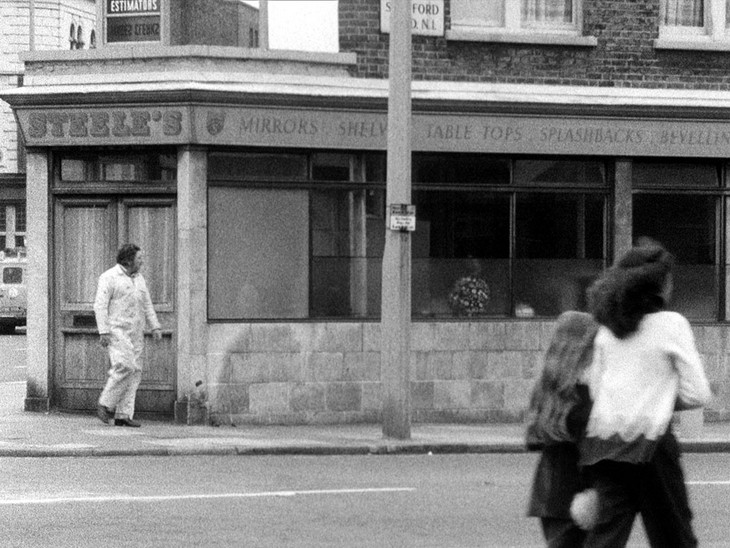
John Smith
The Girl Chewing Gum 1976 (film still)
12 min
Courtesy the artist and Tanya Leighton Gallery, Berlin
Fig.2
John Smith
The Girl Chewing Gum 1976 (film still)
Courtesy the artist and Tanya Leighton Gallery, Berlin
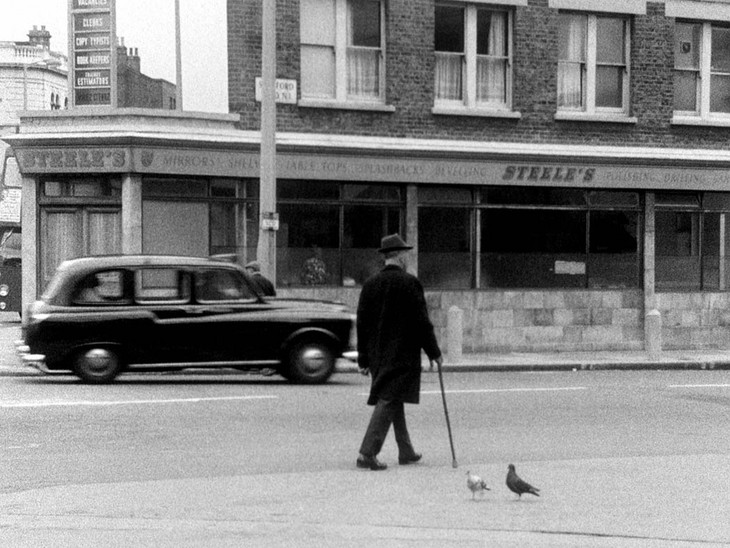
John Smith
The Girl Chewing Gum 1976 (film still)
Courtesy the artist and Tanya Leighton Gallery, Berlin
Fig.3
John Smith
The Girl Chewing Gum 1976 (film still)
Courtesy the artist and Tanya Leighton Gallery, Berlin
Smith’s voice directs not only the scene, but the viewer as well, guiding him or her to focus on certain aspects of the image and to apprehend those aspects in particular ways. When the voiceover says ‘Right, let’s have the man in the white boiler suit coming in from the right’, the viewer scans the image in search of him at the expense of paying attention to other things happening in the frame. His appearance on the far side of the street in the background on the left – not the right as directed – detracts notice from two women who pass in the foreground, even though they occupy a position of greater pictorial importance (fig.2). In addition to directing the spectator’s gaze, the voiceover plays a central role in determining what sense one makes of what one sees. Put differently, it influences not only identification, but interpretation as well. We see a man with a cane walking down the road (fig.3). He could be going to any number of places for any number of reasons; the image contains within it a vast reserve of potential meanings. When the voiceover volunteers that ‘The man with a walking stick is going home’, it accomplishes a pruning away of undesired possibilities (the man is a wounded war veteran, the man uses his cane to beat his dog) and anchors one chosen signified to the image. Although this example is quite innocuous, it is easy to see how instrumental the operation of anchorage can be in the ideological functioning of images. As Barthes wrote, ‘With respect to the liberty of the signifieds of the image, the text has thus a repressive value and we can see that it is at this level that the morality and ideology of a society are above all invested’.11

Luis Buñuel
Land Without Bread 1933 (film still)
Fig.4
Luis Buñuel
Land Without Bread 1933 (film still)
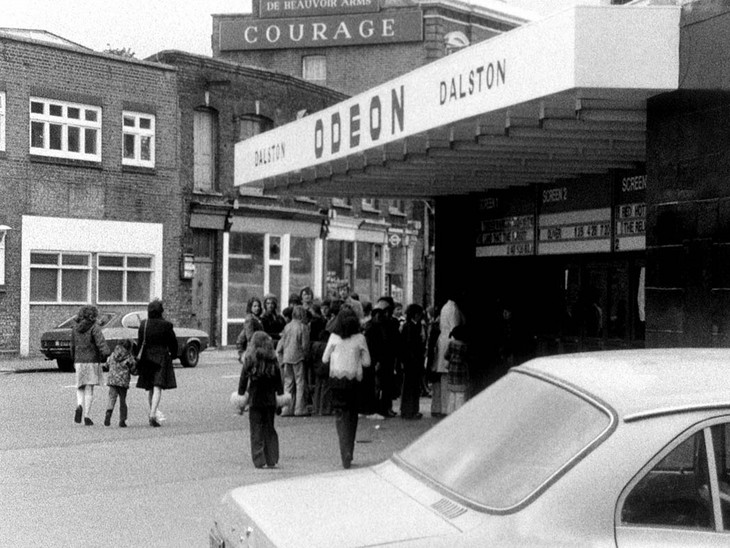
John Smith
The Girl Chewing Gum 1976 (film still)
Courtesy the artist and Tanya Leighton Gallery, Berlin
Fig.5
John Smith
The Girl Chewing Gum 1976 (film still)
Courtesy the artist and Tanya Leighton Gallery, Berlin
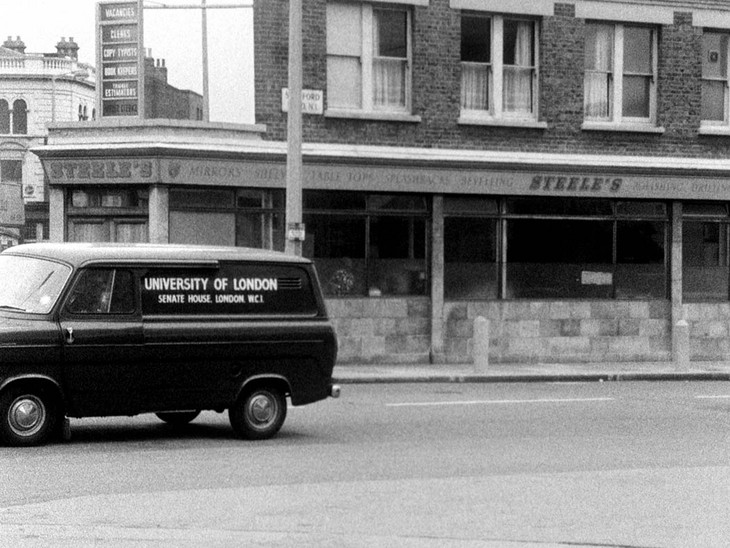
John Smith
The Girl Chewing Gum 1976 (film still)
Courtesy the artist and Tanya Leighton Gallery, Berlin
Fig.6
John Smith
The Girl Chewing Gum 1976 (film still)
Courtesy the artist and Tanya Leighton Gallery, Berlin
There are key moments in which Smith plays with the synchronisation of sound and image so as to throw a wrench in the usual functioning of anchorage. Roughly halfway through the film, the camera comes to rest on the exterior of the Dalston Odeon, with a queue waiting in front (fig.5). The voiceover mentions a man in a turban and a van marked ‘Senate House, WC1’, but neither can be found. He continues, ‘In the cinema queue I want to see a boy and his mother. The boy will be about eight years old and his mother about thirty-two. They’ll both have collar-length hair, his dark and hers fair. She will be wearing a suedette coat with a white imitation fur collar. They’ll be talking to each other and looking around them’. Scanning the crowd, it is not possible to identify anyone who fits the description Smith has provided. At the mention of the woman’s coat, the camera begins to pan left away from the cinema, so that the queue is completely out of frame. The viewer is being directed to look for something that he or she simply would never be able to see. The voiceover has offered a selected signified, but no signifier to match can be found, troubling the production of a stable meaning. After a perfect sound-image synchronisation of a man putting on his glasses, the voiceover speaks once again of mother and child – ‘The boy will look at his watch and yawn, then look at it again and say something to his mother about the time’ – but the cinema queue remains out of frame. What is visible, however, are the man in the turban and the Senate House van, mentioned roughly one minute before (fig.6). Almost four minutes later, after the geographical location of the voice has been revealed and its narration is about to end, the camera comes once more to the cinema queue, where the mother and boy are clearly visible, clothed exactly as the voiceover had said they were (fig.7). But by now, the notion that the text might serve to successfully anchor the meaning of the image by identifying figures of interest and supplying interpretive details has been thrown into crisis. How are we to know that the woman is indeed thirty-two, not coincidentally the same age as the woman of Buñuel’s Land Without Bread? She might easily be twenty-eight, or she could be forty; she is one face among a crowd and too far away to know. And perhaps her fur collar is real rather than imitation? By the end of The Girl Chewing Gum, the narrator’s authority has been so thoroughly undermined as to restore the liberty of the photographic signifieds.
This sequence is of central importance for an additional reason, one that has to do with the same thing the boy in the cinema queue spoke to his mother about: time. From the beginning The Girl Chewing Gum establishes a tight synchronisation between the commands issued on the soundtrack and their execution by the image, one that it largely retains throughout. The synchronised sound of the street scene aids in the creation of a reality-effect, and the soundtrack is presumed to be a single unitary whole. But in the case of the mother and son, this synchronisation is disrupted as the voice supplies information prematurely, identifying figures that will only appear onscreen later. This disjunction between sound and image tugs at the tight suture that had existed between them, opening the possibility that the voice may be speaking from a different temporal position than originally assumed. Even before the disclosure of the geographical location of the narrator, this lack of synchronisation gestures to the film’s process of construction by suggesting that the voiceover is – if not clairvoyant – occupying a time after the image. This destabilising of the temporality of the soundtrack is exacerbated shortly thereafter when another mother, ‘firmly gripping the hands of her two young sons’, stops to cross the road. The narrator says ‘They stop– ’, at which point the street noises cut out and the soundtrack is quiet. He continues against a silent background, ‘–and now they cross the road’. As they begin to walk, the street noises return. Smith has here made clear the presence of two soundtracks that had been masquerading as one, cleaving their unity and putting into question the place and time from which the narrator speaks.
The heterogeneity of film’s soundtrack and the foregrounding of the belatedness of the voice have two important ramifications for Smith’s critique of documentary naturalism. Firstly, it means that the voice speaks not as witness to the street scene but as viewer of the film of the street scene, which can be screened repeatedly so as to familiarise oneself with the sequence of events. This attenuates the relation to the profilmic and foregrounds the image-track as representation rather than reality. Secondly, it fractures the temporality of the film, for what had been apprehended as a single unfolding present is now recognised to be a heterogeneous time in which non-simultaneous recordings of sound and image are rendered simultaneous only through the means of filmic construction. Their apparent unity is shown to be the result of post facto assembly. The artifice of post-synchronised sound is, of course, the truth of most films, but this fact is normally disavowed so as to produce an impression of reality. As the composer and film theorist Michel Chion has suggested, ‘The talking film is but a jerry-rigged assemblage ... Instead of denying this rigging, it can choose it as its subject matter, taking that route, under the sign of the impossible, to the very heart of the effect of the Real’.13 The Girl Chewing Gum inhabits this impossibility to reveal it as such, thus adding a critique of the reality-effect of synchronised sound to its analysis of the signifying operations of the voice of god.
Notes
Michel Foucault, The Order of Things: An Archaeology of the Human Sciences [1970], London 1989, p.10.
See, for example, ‘Fires Were Started’, Monthly Film Bulletin, vol.10, no.112, April 1943, p.47. For more on this see Brian Winston, ‘Fires Were Started– ’, London 1999, pp.58–66.
For a discussion of structural/materialist film and the Co-op at this time, see Erika Balsom, ‘A “New Face” at the Co-op’, September 2015, in Erika Balsom (ed.), In Focus: ‘The Girl Chewing Gum’ 1976, by John Smith, September 2015.
John Smith, quoted in Catherine Elwes, ‘Trespassing Beyond the Frame’, in Mark Cosgrove and Josephine Lanyon (eds.), John Smith: Film and Video Works, 1972–2002, Bristol 2002, p.64.
John Smith, ‘Real Fiction’, paper submitted in partial fulfilment of the requirements for Smith’s PhD, University of East London, December 1997, p.10. Courtesy of British Artists’ Film and Video Study Collection.
Pascal Bonitzer, ‘The Silences of the Voice (A propos of Mai 68 by Gudie Lawaetz)’, trans. by Philip Rosen and Marcia Butzel, in Philip Rosen (ed.), Narrative, Apparatus, Ideology: A Film Theory Reader, New York 1986, p.324.
For a further elaboration of this distinction and its implications, see Mary Ann Doane, ‘The Voice in the Cinema: The Articulation of Body and Space’, in Rosen (ed.) 1986, pp.338–41.
Roland Barthes, ‘The Rhetoric of the Image’, in Image Music Text, trans. by Stephen Heath, New York 1977, p.39.
Michel Chion, The Voice in Cinema, trans. by Claudia Gorbman, New York 1999, p.151. It is worth noting that Chion had in mind here films very different than The Girl Chewing Gum, namely feature-length narrative films that problematised the embodiment of the voice, such as Fritz Lang’s The Testament of Dr Mabuse (Das Testament des Dr Mabuse) of 1933 and Kenji Mizoguchi’s 1954 film Sancho the Bailiff (Sansho Dayu). Nonetheless, his insight remains extremely pertinent to Smith’s play with synchronisation.
How to cite
Erika Balsom, ‘(Not) the Voice of God’, September 2015, in Erika Balsom (ed.), In Focus: 'The Girl Chewing Gum' 1976 by John Smith, Tate Research Publication, 2015, https://www

